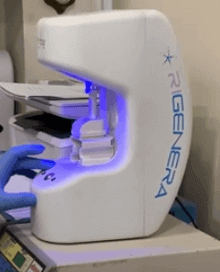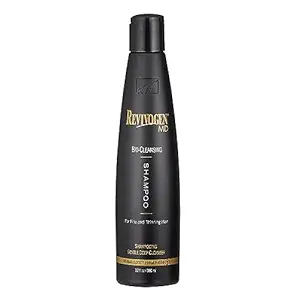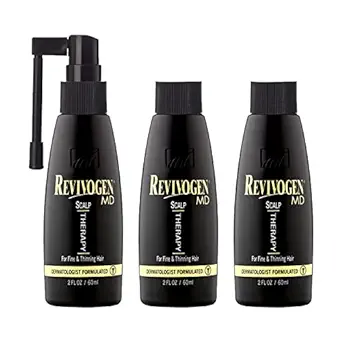
We have heard about the Regenera Activa® (also spelled Rigenera) hair loss treatment regularly since 2019.
I briefly mentioned it in several posts, including when discussing Dr. Cooley’s 2018 presentation on stem cells and hair restoration.
Edit: On Instagram, Regenera Activa often posts monthly best case hair growth before and after photos.
Update: July 11, 2022
A recent article in GQ Magazine UK covered “micrografting hair transplants“. I think this is a misnomer, since the original meaning of micrografting entails moving actual “micro” grafts of I or 2 hair follicles per graft during a hair transplant procedure. In this case, the technology described is not really a hair transplant.
Under local anaesthetic, a biopsy is taken from the back of a patient’s neck. Tiny skin grafts are taken from the hair line area (the article calls these the strongest follicles). These “micrografts” are:
“Placed in a special device in order to extract the stem cells, progenitor cells (like stem cells but more targeted and potent) and growth factors before the mixture is injected back into the scalp where the hair is thinning.”
The article mentions two medical papers that support the efficacy of this treatment. Lo and behold, when I searched for these studies, both mentioned the technology (and device) being used as Regenera Activa.
- The first was published in November 2021 by a Saudi Arabian doctor. It is titled: “Short-Term Efficacy of Autologous Cellular Micrografts in Male and Female Androgenetic Alopecia”.
- The second was published in October 2019 by Spanish researchers. It is titled “Progenitor-cell-enriched micrografts as a novel option for the management of androgenetic alopecia.”
The author of this GQ article, Jeremy Langmead, is satisfied with the results and states as follows:
“Dermoscopic imaging of my hair and scalp (a trichoscopy) showed a significant increase of average hair density, a significant increase of average hair shaft thickness, and a significant decrease of thin hair count. Basically, the hair density around my crown has already improved, as has the coverage. I was mighty pleased.”
At the UK based Ouronyx that Mr. Langmead visited, the cost of this one 45 minute treatment session was £2,850. On their site, they warn that this treatment will not create new hair follicles. i.e., if you have totally bald regions of the scalp, do not expect hair follicle reincarnation.
However, other sites suggest that some miniaturized fine hair can become terminal with this procedure. Moreover, the second study that I mentioned above states that Rigenera® micrografting technology can promote derma and bone regeneration.
December 2, 2021
Regenera Ativa and PRP Combination
Many doctors use both Regenera Activa and platelet-rich plasma (PRP) together to help stimulate hair regrowth. Both procedures are autologous in nature and therefore unlikely to cause any major side effects in the hands of experienced practitioners. While PRP contains more growth factors, it does not contain progenitor cells like Regenera does.
At least 20 people have commented about this stem cell based treatment over the years. It is far more popular in Europe and Asia than in the US, although the Regenera device is approved for use by the US FDA.
I was not keen to write an entire post on the product till 2021. For one, online reviews and forum testimonials are all over the map, and lean towards significant skepticism. However, things are getting more interesting now.
Regenera Activa AMT

Most new hair loss technologies and companies tend to see diminished social media presence over the years. Most also stop updating their websites or make sporadic changes. For a while, I thought Regenera Activa was becoming stagnant.
However:
- Since my last visit over a year ago, Regenera has made a complete overhaul of its website. It seems like the Rigenera spelling is now being avoided.
- They now offer a pdf that recommends using the Regenera Activa treatment alongside a hair transplant procedure.
- They have re-branded their product as AMT® . An acronym that stands for Autologous Micrografting Technology.
- A new November 2021 study from Saudi Arabia concludes that Regenera Activa benefits hair growth positively. In both males and females; and in both hair quantity and hair thickness. Note that this technology is described as Autologous Cellular Micrografts (ACM).
- Also in 2021, Dr. Antonella Tosti (Italy) made a video webinar presentation on AMT Regenera. It includes before and after positive hair growth results from a small study of 17 people. Her patients on average saw a significant increase in frontal hair thickness, but no significant increase in hair count.
- The Spain based company maintains regularly updated Instagram and Facebook pages.
- The number of hair transplant surgeons offering Regenera Activa stem cell treatment is growing very rapidly. The latest video from yesterday comes all the way from Pakistan:
How Does it Work?
As seen in the above video, the Regenera Activa method involves three main steps.
- The first stage entails extraction of of 3-5 small scalp skin samples using a 2 mm punch biopsy. These extractions are collected from the occipital region of the scalp that is least susceptible to androgenic alopecia. i.e., from the permanent donor zone area that is also utilized during hair transplant procedures.
- The extracted skin samples are then placed in the Rigeneracon device. They undergo centrifugation at a speed of 80 rpm for 2-6 minutes. The resulting filtered solution contains stem cells, growth factors, extracellular matrix and progenitor cells.
- Finally, the resulting mixture is injected into the scalp. The mixture of stem cells and growth factors is though to help shrinking hair follicles in balding areas to regenerate.
Pricing
The price of one session of Regenera Activa hair loss treatment varies by country and clinic. However, the range is not as wide as is the case with PRP. Note that a surgeon might offer it at a steep discount if you are also getting a hair transplant with him or her. According to the Daily Mail, the UK price at Vie Aesthetics is £2,000. In the US, most clinics seem to be advertising the price at $3,000.
When first researching this subject in 2018, I bookmarked a page about this procedure from Singapore based Dr. Gerard Ee’s website. You can see him in action in this video.


